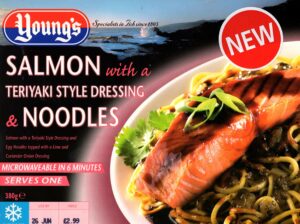Meal deals

The ‘value added’ packaged salmon meal was an idea that came and went, as Dr Martin Jaffa reports.
I’m in the process of moving office and the move offers the opportunity for a clear-out of files, books and other miscellanea accumulated over 30 years. One of the collections includes several hundred examples of packaging that appeared in retail from the early 1990s onwards. As well as simple labels, there are hundreds of card outers from the packaging of added-value salmon products. They represent a memory of the past advances of the salmon farming industry in the UK.
One of the reasons salmon was selected as a potential candidate for farming was its then premium market image. Initially, its scarcity meant salmon could command a premium price, but by the end of the 1980s increased farmed production meant salmon became much more widely available.
The downside was that this availability undermined its market image as well as the price. Salmon farming had evolved from an industry of high margins and low volumes to one of low margins and (relatively) high volumes. The price of farmed salmon fell.
The question was what to do. The salmon farming industry blamed Norway for cheap imports and embarked on a dumping case against Norway at the European Commission. Meanwhile, salmon processors began to realise that low-cost salmon offered the chance to diversify the market and reach a greater range of consumers. Their approach was to emulate the market development of the broiler chickens. At the time, salmon farmers focused on selling whole salmon, but broiler producers recognised that chicken breasts, legs, wings etc were more attractive to consumers than whole chicken for most meal choices. The same approach was taken with salmon as consumers were more likely to buy a couple of fillets for one meal than using a whole fish, even a small one.
Anyone for salmon lasagne?
However, as the 1990s progressed and while the industry was still pursuing its case against Norway at the EU, the low cost of salmon meant that it was the ideal base for production of a whole range of added-value products, including meal choices. I have provided images of some of the products I found of most interest but at the time these were just the tip of the iceberg. For example, the Italian range found in most supermarkets expanded from spaghetti bolognaise to cannelloni to lasagne to vegetable lasagne to eventually include salmon lasagne. This acted as an introduction to salmon in a dish that was already familiar to consumers. More complex dishes included those giving a variety of ethnic options.
However, the fate of many of these dishes was sealed when salmon farming companies began to be listed on the stock exchange. Financial analysts were not interested in consumers and what they wanted to eat. Their interest was focused on the share price and this was inevitably linked to the price of salmon. High salmon prices meant high share prices and pleasing the shareholder became more important than pleasing the market.
With time, salmon prices rose, encouraged by the analysts. Sadly, rising prices meant that salmon was no longer commercially viable for inclusion in added-value products. The value was now on the salmon itself and consequently within a short time, most added-value salmon products vanished from the consumer shelves.
This was a slow decline during which processors tried to substitute farmed salmon with Pacific pink salmon, but the taste was not the same and such products did not fare well.
Added-value salmon dishes have not disappeared completely from the retail sector. Some still exist but they tend to be at the top end of the market because otherwise the sums don’t add up. There are some cheap options, but these tend to be made from trimmed pieces rather than fillet, simply because they are cheaper. They are also established, familiar favourites rather than novel developments.
I have always believed that, as with the poultry industry, the real advantage of added value comes when it is the primary producer that adds the value. Farming companies were not reluctant to take this on board. In fact, it was a processor from Belgium that first saw that integrated production was the way forward and instead of a farming company buying into processing, a processor bought a farm. This arrangement subsequently became of interest to other farming companies and eventually led to interest being shown by others too.
The original Belgian operation was acquired by another farming company, specifically because of its processing capability. Today, there is some integration of processing within the salmon sector, but its real potential is being stifled by the cost of salmon.
Although we are now seeing more added value salmon products reappearing in the retail market, the numbers are nowhere near those of the 1990s and early 2000s. The continued presence of financial analysts means that the focus remains on what happens to share prices rather than what’s happening in the consumer market.
In the UK, salmon dominates fish consumption, but established fish consumers tend to be older. Added-value development is the main way to target the younger end of the market, but the industry risks missing out, especially in the long term, as long as the cost of salmon remains too high for widespread processing into innovative products that might appeal to the young.
Meanwhile, my collection of packs will not be wasted. It has found a new home, with people who also see such opportunities in the retail sector.


